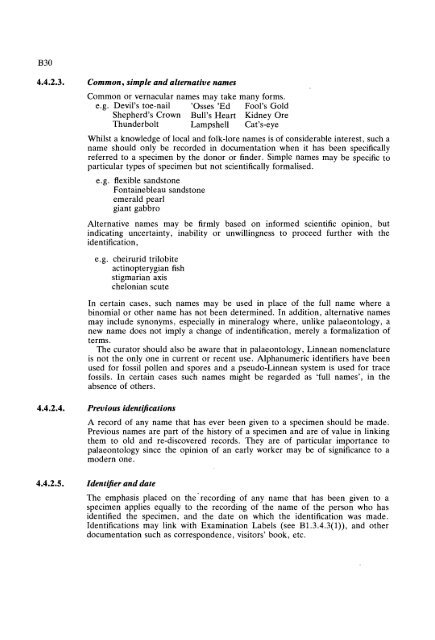GUIDELINES FOR THE CURATION OF GEOLOGICAL MATERIALS
GUIDELINES FOR THE CURATION OF GEOLOGICAL MATERIALS
GUIDELINES FOR THE CURATION OF GEOLOGICAL MATERIALS
You also want an ePaper? Increase the reach of your titles
YUMPU automatically turns print PDFs into web optimized ePapers that Google loves.
4.4.2.3. Common, simple and alternative names<br />
Common or vernacular names may take many forms.<br />
e.g. Devil's toe-nail 'Osses 'Ed Fool's Gold<br />
Shepherd's Crown Bull's Heart Kidney Ore<br />
Thunderbolt Lampshell Cat's-eye<br />
Whilst a knowledge of local and folk-lore names is of considerable interest, such a<br />
name should only be recorded in documentation when it has been specifically<br />
referred to a specimen by the donor or finder. Simple names may be specific to<br />
particular types of specimen but not scientifically formalised.<br />
e.g. flexible sandstone <br />
Fontainebleau sandstone <br />
emerald pearl <br />
giant gabbro <br />
Alternative names may be firmly based on informed scientific opinion, but<br />
indicating uncertainty, inability or unwillingness to proceed further with the<br />
identification,<br />
e.g. cheirurid trilobite <br />
actinopterygian fish <br />
stigmarian axis <br />
chelonian scute <br />
In certain cases, such names may be used in place of the full name where a<br />
binomial or other name has not been determined. In addition, alternative names<br />
may include synonyms, especially in mineralogy where, unlike palaeontology, a<br />
new name does not imply a change of indentification, merely a formalization of<br />
terms.<br />
The curator should also be aware that in palaeontology, Linnean nomenclature<br />
is not the only one in current or recent use. Alphanumeric identifiers have been<br />
used for fossil pollen and spores and a pseudo-Linnean system is used for trace<br />
fossils. In certain cases such names might be regarded as 'full names', in the<br />
absence of others.<br />
4.4.2.4. Previous identijications<br />
A record of any name that has ever been given to a specimen should be made.<br />
Previous names are part of the history of a specimen and are of value in linking<br />
them to old and re-discovered records. They are of particular importance to<br />
palaeontology since the opinion of an early worker may be of significance to a<br />
modern one.<br />
4.4.2.5. Zdentijier and date<br />
The emphasis placed on the recording of any name that has been given to a<br />
specimen applies equally to the recording of the name of the person who has<br />
identified the specimen, and the date on which the identification was made.<br />
Identifications may link with Examination Labels (see B1.3.4.3(1)), and other<br />
documentation such as correspondence, visitors' book, etc.

















